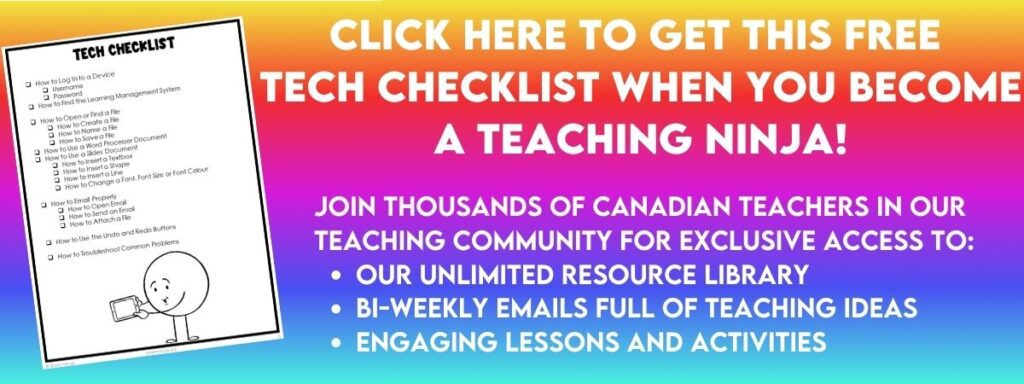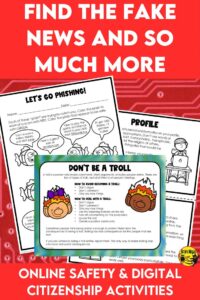
We realized the importance of teaching critical thinking and fact-checking one day on Facebook. One ninja-mother-in-law posted an article about an actor that had died-but the actor had died FIVE years earlier. Yet, there she was just reposting like crazy. A dog with a piece of ham on its face was her next post and that was when we started writing our digital citizenship and online safety resource. Clearly, digital citizenship is a skill to be learned by many these days.
We knew digital citizenship and safety were problems in our classrooms. Students were reposting things without fact-checking. They were quoting incorrect information in their research. In this era of “fake news,” we knew we had to start teaching students to think critically and use the internet for more good than bad. It’s going to take a shift in thinking from everyone, but if we start now there is hope (and not this ‘ham on a dog’s face can you give me an amen’ kind of hope).
What should students be learning about online safety?
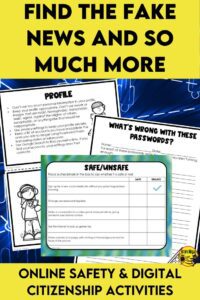
- Personal information: Students need to learn how to protect themselves and others online by not giving away their personal information. Too often we don’t think about how accessible our information is to others online and once it’s out there, it’s impossible to control where it goes.
- Passwords and security: Students need to know how to create effective passwords and how to protect them (usually by telling others). Even full-grown people need to learn about creating passwords that cannot be easily guessed by others (like birthdays, pet names and addresses).
- Negativity: Students need to understand it’s not rude to block or report negative messages, particularly messages that have a racist, sexist or violent tone. There is no place in the world for these types of messages or the people who post them, so reporting them is just one way to help prevent others from seeing them, too. Blocking means students won’t have to see it in the future.
- Personal safety: Students need to understand that not everyone online is showing who they really are. They need to know that people they “meet” online may be dangerous so they should keep their online activities out in the open and share what they are doing with friends and family members. If they are hiding it, they are probably not supposed to be doing it.
Part of being a good digital citizen includes looking after devices. Read our post How to Avoid Device Disaster.
What are some digital safety and citizenship activities you can do?
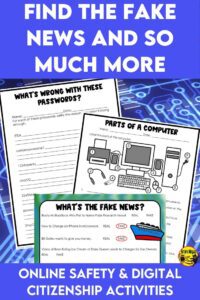
We have been teaching our students about digital safety since we started putting them out on the internet, but we have refined the skills to include everything from viral videos to fake news and everything in between.
Often we teach about bullying, but now we’ve included lessons about passwords, privacy, scams and phishing as well.
The lessons in our digital safety and citizenship set were not only tested by fourth and fifth graders but the ninja-mother-in-law was forced to complete them all before returning to Facebook. There is a great improvement and now she is much more careful about what she is sharing. She even reported a fake news story she saw online. You can find our complete lessons in our TpT Store ($USD) or our BN Shop ($CAN).
Ninja Note: Our favourite part of the unit we created was the fake news stories. We might have had too much fun coming up with prairie whales. They were actually inspired by a real project a student did for us. In studying the geography of land-locked Alberta, students were asked to collect pictures of animals from Alberta. One student included an Orca in his presentation and when we asked why he told us it was a prairie whale. He was obviously misinformed, but we used it to our advantage.
Related: We have more online safety activities mentioned in this Stop Overlooking Health Class post.
What other digital citizenship activities are available online?
You might have heard about the mighty endangered Pacific Northwest Tree Octopus. This entire website was created to show students that not everything they read online is true. Create a mini-lesson by sending students to the website to do some research and then talk about why it’s important to verify information found online. The same information should be found on several websites by different authors. If it isn’t, it’s possible the information is not completely accurate. Books have to be fact-checked in order to be published, but anyone can create content and post it online.
Google has created an amazing site called Be Internet Awesome. Students get to play games in different kingdoms to learn different ways to be responsible online. This one does have quite a bit of reading, but if students have headphones they can listen to all the rules and lessons.
My aunt once posted a warning that these two guys were breaking into homes in the neighbourhood. It was a shared post and when I told her they were the two guys from the movie Home Alone, she didn’t believe me. I had to look up a movie clip for her. She has a masters degree in library sciences.
~Lailla Age 12
Common Sense Education has a website full of resources for teachers to use in their classrooms. There are entire sets of lessons available by grade level.
Google for Education has also created all kinds of interesting lessons. You’ll have to do a bit of digging to find lessons for your specific students, but it’s full of ideas. We recommend this one for grades five and up because it requires a bit more searching and reading.
Why should students be learning to think critically when online?
Education has changed. Gone are the days when the teachers were the keepers of the knowledge. Now students can look things up in an instant, but they need skills to understand how to tell if the information they are seeing and reading is accurate.
We teach our students to look at several things when doing their online research.
- can this information be found in more than one place online?
- who are the authors of this information? Do they work for a specific company, organization or anything that would be biased?
- when was this information published/uploaded?
- is this site a .com .org .edu .ca? The website’s location might indicate whether or not the source is reliable.
- is the site authoritative? By this we mean is it a site with reliable information free of spelling, and grammar errors. Does the site make sense and sound like it was written by an expert?
- can I find this information in a book, too?
Students need to know what they should or shouldn’t share.
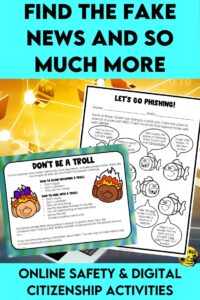
Who doesn’t love a great meme? We certainly do, but we would never post any pictures of our students, their families or any information about them.
Students need to know exactly where the line is. As more and more students bring personal devices to school, it becomes even more important to clear policies.
We’ve been at schools where the policy is open to devices. There are schools where there is no use permitted at all. It honestly depends on your students and how responsible they can be.
When we’ve had no ban on devices, students understood that they were not allowed to take any pictures, videos or sound recordings at school at all and devices were only permitted in class when they were being used for work. Students were responsible for keeping their devices secure, but we also informed parents that they were not to be texting students during school hours. Honestly, the parents were more trouble than the students in this regard.
When we’ve had a ban on devices, we’ve had fewer interruptions in class time, but we’ve also missed out on the opportunity to use these devices for learning in class. Students got used to the policy, but we did have parents complain that they couldn’t text their children during the school day.
A Story From a Student…
My grandmother calls me all the time to tell me about all the stuff she reads on the internet. She was mad because the premier of Alberta was going to build a river through BC. It was from a TV Show called the Beaverton that makes parodies of news stories. She thought it was real.
~ Bernie Age 13
Students need to understand that sharing someone else’s personal information, videos or photos is not okay. They need to get consent to share these things. More importantly, if they share inappropriate material they can be charged with a crime (depending on local laws).
A local story from the news took place in a junior high washroom where a girl made a live stream video from the changing room where a few girls were changing in the background. She passed the video to a friend and the video went viral from there. Any student caught with the video on their device or anyone who had shared the video was charged with the distribution of pornography of a child under the age of 16. Talk about consequences and a lesson learned!
It is not hard to find all kinds of similar news stories by simply searching “teen charged with child pornography.” These are stories we share with our older students so they can understand their actions have real-world consequences.
How can you keep students safe online in the classroom?
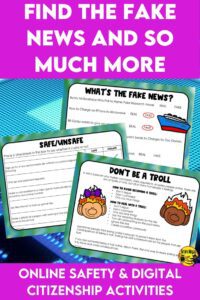
Simple rules: We had one rule when students were online. You will be where we said you can be and nowhere else. This just meant that we needed to know exactly where they were at all times. They could only be on sites we approved.
Visible screens: Students should be sitting in such a way that you can see their screen at any time.
Report: Teach your students to report anything they see online (even by accident). We were once searching for information on the Spice Girls and a typo led to spicy girls. The poor kid! This was before all the safe search settings were established by our district. It was still a lesson for all of us.
Model: Show your students how to behave online by modelling it for them.
Use Links: If you think your students will wander, use a web page with all the links your students need to visit. Google Classroom is great for this because you can just add the links you want your students to use by listing them in the assignment. Use Google Sites to create a class website where students can access all the links without searching randomly online.
Be honest: Don’t scare kids, but don’t sugarcoat it. Students need to understand the dangers so they can be responsible for their safety. The world is so much bigger than it was because the entire world is at our fingertips. Students need to know they can use the web safely, but they have to be responsible, too.
What is missing?
Do your students need a basic tech check? We use this checklist to get started. You can find it in our Resource Library if you’re already a ninja. If you’re not on the list yet, sign up here and we’ll send the list directly to your inbox. You’ll also get access to our Resource Library. Read more in our post Must Know Tech Skills You Should Teach Your Students or More Advanced Tech Skills You Should Teach Your Students.
Do you use YouTube in your classroom? Read How to Leverage the Power of YouTube in Your Classroom.
What digital citizenship skills are students still missing? Which struggles do your students face online? Let us know your thoughts in the comments below. We might be able to add them to this post so other teachers can benefit from them, too.

